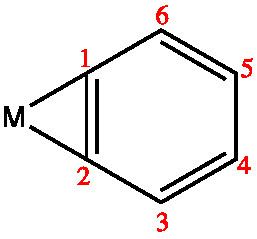 | ||
Transition metal benzyne complexes are organometallic complexes that contain benzyne ligands (C6H4). Unlike benzyne itself, these complexes are less reactive although they undergo a number of insertion reactions.
Contents
Examples
The studies of metal-benzyne complexes were initiated with the preparation of zirconocene complex by reaction diphenylzirconocene with trimethylphosphine.
Cp2ZrPh2 + PMe3 → Cp2Zr(C6H4)(PMe3) + PhHThe preparation of Ta(η5-C5Me5)(C6H4)Me2 proceeds similarly, requiring the phenyl complex Ta(η5-C5Me5)(C6H5)Me3. This complex is prepared by treatment of Ta(η5-C5Me5)Me3Cl with phenyllithium. Upon heating a solution of this complex, methane was lost, leaving the benzyne complex:
Ta(η5-C5Me5)(C6H5)Me3 → Ta(η5-C5Me5)(C6H4)Me2 + CH4The nickel derivative Ni(η2-C6H4)(Cy2PCH2CH2PCy2) was the second type metal-benzyne complex to be reported and structurally characterized. Synthesis involves dehalogenation of the chlorophenyl complex NiCl(C6H4Br-2)(Cy2PCH2CH2PCy2) with sodium amalgam, which furnished the yellow nickel(0) benzyne complex. Its coordination geometry is close to trigonal blanar and the benzyne ligand was determined to be planar. However, both the nickel and phosphorus atoms were found to be slightly displaced to one side of the benzyne plane. This complex reacts with a variety of electrophiles. With trifluoroacetic acid, benzene is lost to give the trifluoroacetate:
Ni(η2-C6H4)(Cy2PCH2CH2PCy2) + 2 CF3CO2H → Ni(O2CCF3)2(Cy2PCH2CH2PCy2 + C6H6Structural trends
Several benzyne complexes have been examined by X-ray crystallography.
